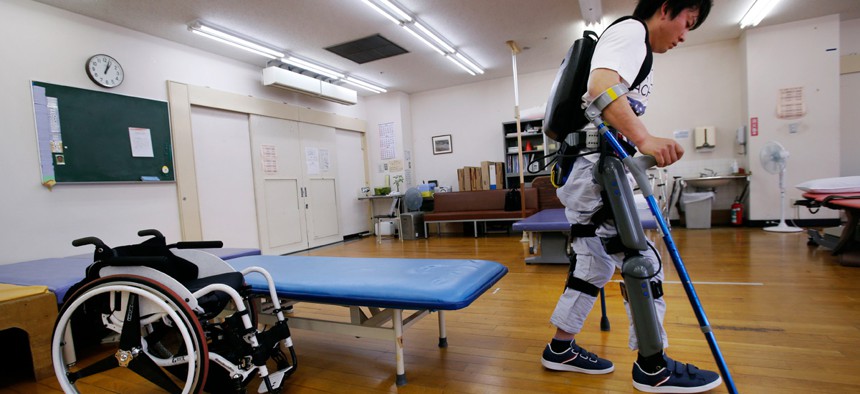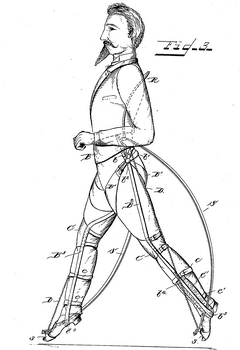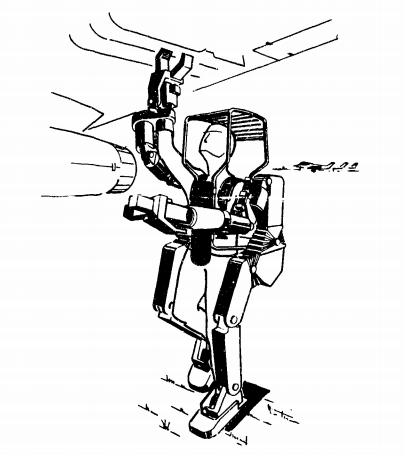The Exoskeleton's Hidden Burden

Yuichi Imahata walks using a robotic exoskeleton called ReWalk at Kanagawa Rehabilitation Center in Atgugi, west of Tokyo. Imahata, 31, has been using a wheelchair to get around for seven years after a serious spinal-cord injury. Shuji Kajiyama/AP
A growing number of companies are developing assistive technologies to help disabled people walk—but these devices can distract from infrastructure changes that would make cities more disability-friendly.
Last year, a man in an exoskeleton kicked off the Men’s World Cup.
Juliano Pinto, a 29-year-old from Brazil, was outfitted by a team of scientists from the Walk Again Project with a complex framework of braces and metal armature that could all be controlled by his brain. And it worked: He was able to command his reinforced legs to strike the ball.
Over the past few years, exoskeletons, which can seem like the realm of science fiction, have become quite real. Several companies and research groups are working on designs for exoskeletons that cater to people who currently use wheelchairs. Last year, the Food and Drug Administration approved a device called ReWalk, the first (and still only) exoskeleton commercially available in the United States. Thus far, 66 people have purchased the ReWalk at $77,000 a pop.
There are plenty of reasons to celebrate exoskeletons. They allow some people to stand and move about in ways they couldn’t before, and others to regain abilities they’ve lost. And the ReWalk has some serious fans, who love the mobility it gives them. One researcher who conducted a 2012 study on the safety of the ReWalk later said that many participants were moved to tears once they got up and walked with the device.
But the solution offered by these devices also illuminates a problem they’ve helped to create. In thinking about the limits of exoskeletons, it’s perhaps most important to think about why many people seem more interested in hoisting someone out of their wheelchair than they are in making spaces accessible to that chair.
* * *
Powered exoskeletons did not start as assistive devices. The first patent for a powered exoskeleton, filed by a Russian inventor named Nicholas Yagn, was approved on January 28, 1890. Yagn’s “apparatus for facilitating walking” involved long springs attached to each leg, designed to give soldiers in the Russian Army an advantage when running. There is no documented evidence that Yagn’s device was ever actually built or operated.

(Nicholas Yagn/USPTO)
In the 1960s, inventors began to create elaborate powered exoskeletons, a rise fueled once again by the military. In 1965, with funding from the U.S. military, General Electric started developing something called the Hardiman, whose name was a mashup of “Human Augmentation Research and Development Investigation” and “MANipulator.” The machine was huge—once built, it would weigh 1,500 pounds, and was meant to amplify the strength and endurance of human arms and legs. “Man and machine can be combined into an intimate, symbiotic unit that will perform essentially as one wedded system,” the G.E. engineer Ralph S. Mosher wrote in a report on the Hardiman.
But the Hardiman never quite lived up to the hopes and dreams of its creators. In 1970, engineers finished building the leg and girdle systems, but they weren’t able to walk or stand up without support, and the project was abandoned the following year.
At the same time that G.E. engineers were working on the Hardiman, scientists in Belgrade were also experimenting with powered exoskeletons, this time for use on patients with various forms of paralysis. In 1970, the researcher Miomir Vukabratovic designed what he called a “partial active exoskeleton.” Unlike the Hardiman, this exoskeleton was far lighter (just 26 pounds) and was successfully built and tested on humans in over 100 clinical trials. But Vulabrotavic’s exoskeleton had no power source integrated into the device, and the limitations of the motor and battery technology of the time made the exoskeleton unusable.
It wasn’t until around 2000 that powered exoskeletons really passed from dream into working reality. That was the year that the Defense Advanced Research Projects Agency funded a project called the Berkeley Lower-Extremity Skeleton, or BLEEX. The BLEEX system, developed by engineers at the University of California, Berkeley, only includes legs, and the wearer has to carry the power supply and computer for the device in a large backpack. The premise of this system isn’t to help disabled people towalk again, but rather to make carrying large loads over long distances less exhausting. “While wearing the exoskeleton, the wearer can carry significant loads over considerable distances without reducing his/her agility, thus significantly increasing his/her physical effectiveness,” the researchers write.

1971 report (General Electric)
Since then, a whole battery of exoskeletons for different purposes have been developed specifically with disability in mind. In addition to ReWalk, there’s the eLEGS system, HAL, and MindWalker, to name a few. In 2009, a group at MIT built an elastic exoskeleton based in large part on Yagn’s springy drawings.
All of these designs are meant to help those who currently cannot walk begin to navigate their homes and cities upright. And while they may draw inspiration from those early drawings, the exoskeletons in development today are far more complex. But the focus on the engineering of metal and steel and neural networks has overshadowed the focus on other, equally important forms of engineering, like social and civic.
* * *
The Americans With Disabilities Act, passed 25 years ago this year, contains several rules and regulations surrounding the design of public spaces. Sidewalks, crosswalks, curbs, signals—all are supposed to be designed with the disabled in mind. There should be “curb cuts” at every intersection, for example, to allow a set of wheels to glide down to the street smoothly.
Enforcement of these regulations can be convoluted. State and local jurisdictions are responsible for ensuring that their building codes comply with the ADA. In some places, it is the responsibility of the Federal Highway Administration to make sure that roads and sidewalks are wheelchair-accessible. Much of the actual enforcement of these regulations is complaint-driven, which means a person has to actually contact the U.S. Department of Justice to report a business that is inaccessible.
Recently, things have turned around a bit, says Marilyn Golden, a senior policy analyst at the Disability Rights Education and Defense Fund. “Here we are at the 25th anniversary of the ADA. They’ve had a long time to do enforcement, and it did take them a long time to get started,” she says. “But in the last 18 months to two years, the [Federal Highway Administration] has been really seriously taking on the enforcement challenge, and getting a bureaucracy that’s used to disregarding these requirements used to implementing them.”
The Department of Justice also has a program called Project Civic Access, which sends inspectors to cities across the country to check on parks, museums, community services, recreation centers, and other buildings for compliance. Since 1999, the project has come to 215 settlement agreements and hit all 50 states, the District of Columbia, and Puerto Rico.
But still, Golden says, there’s a lot of work to be done. “No matter how many hundreds of cities they do, it’s still only a fraction of the many thousands of cities across the country.”
I talked to Golden while she was at a disability-rights conference. I asked her whether there was any city that was set up well for people with disabilities, and people in wheelchairs specifically. She laughed and turned to a nearby group to ask them what they thought. They couldn’t come up with a single one. Half way through our conversation, someone piped up to say that Denver was “decent.”
* * *
Right now, the only FDA-approved powered exoskeleton is the ReWalk, which was designed by a quadriplegic inventor named Amit Goffer. Goffer himself was paralyzed after an accident on an ATV back in 1997, and since then has been working on designing powered exoskeletons to try and help people like himself walk again. He founded his company, now called ReWalk Robotics, in 2001.
The poster patient for the ReWalk these days is Robert Woo, who became a paraplegic after being injured in a construction accident at a building he was helping design: A crane malfunctioned and dropped 14,000 pounds of steel tubes, which fell from 25 stories onto his body.
Woo started working with the ReWalk team back 2011. At that point, he had already done some trials with another exoskeleton team, Ekso Bionics. Using their exoskeleton, he was able to take 300 steps across the floor of Mount Sinai hospital. He started training with the ReWalk a few weeks later, and by the end of 2012, he had completed 68 sessions with their exoskeleton. In a 2013 interview with Gothamist, he said that ReWalk changed his life.
To use the ReWalk, a person has to be a certain size (between 5 feet 2 inches and 6 feet 3 inches, and under 220 pounds) and has to have the necessary bone density to stand and walk. Patients who use the ReWalk also need to have control of their arms, so it doesn’t work for quadriplegics (including its inventor, Goffer). “The current product has FDA clearance for those with spinal-cord injury; there are about 273,000 injured individuals in the US, all of whom rely on a wheelchair,” ReWalk’s CEO Larry Janskinski said in an email. “We can treat the majority of those that have use of their arms, which is over 50 percent.” According to the Disability Statistics Center, in 2000, around 1.7 millionAmericans used wheelchairs or power scooters to get around.
All this is to say that while Woo loves his device—which helps him move around in ways that he couldn’t for many years after his injury—not everybody can benefit from an exoskeleton.
* * *
“We’re at a cultural moment where young people who are going into technology are looking around for research where they can feel purpose,” says Sara Hendren, an artist, designer, and researcher based in Cambridge, Massachusetts, who specializes in assistive-design projects. When they encounter assistive technologies like prosthetics and exoskeletons, she explains, they think they’ve found something that seems like pure good.
“But the problem is that patients are so marginalized from defining their own wishes, that you risk replicating that same top-down assumptions about what people want.” Hendren uses cochlear implants as an example: Inventors assume that a person must want to hear, because they can’t imagine another possibility—but in reality, the Deaf community is quite vibrant, and not everyone feels the need for an implant.
Hendren points out that that putting too much focus on these kinds of devices can also create the idea that there is a “successful” disabled person: that someone who can use an exoskeleton to walk, or a prosthetic limb to run, has succeeded more than someone who cannot. “I worry that an excessive focus on this technology risks romanticizing bootstrapping and overcomer stories,” she says. “I don’t want to diminish what they do, but I don’t want to live in a world where there’s a continued repulsion around dependence. I want to live in a world where it’s okay to ask for help.”
Exoskeletons aren’t the only project that illustrates this issue. Hendren remembers a person who suggested that those in wheelchairs could perhaps carry their own ramps around in case they want to go somewhere that isn’t wheelchair-accessible. Aside from the fact that different settings require different ramps, these sorts of solutions put the onus on the individual to make something usable, rather than on the community. Why should each wheelchair have to come with a toolbox in order to be able to get anywhere?
When I asked Golden later by email what she thought about technologies like the ReWalk, she said that she’d rather see the focus on a different kind of tech: “The key distinction is changing society (which includes infrastructure) vs. changing the individual with a disability (in order to fit into an inaccessible society).”
Janskinski disagreed. “It is easier and better to change the ability of the user to walk over changing infrastructure,” he wrote in an email. And he’s not alone. As a recent collection of disability-themed science-fiction stories called Accessing the Future notes, most of the time, when writers imagine our future bodies, they either erase or “fix” disabled people. And transhumanists like to talk about “repairing” disabled people. In an essay on Motherboard, the transhumanist Zoltan Istvan wrote, “In short, let the sidewalks remain in disrepair. Instead, in the transhumanist age we’re now in, let’s work to repair physically disabled human beings, and make them mobile and able-bodied again.” Many disabled people disagreed.
And here is the tension, the promise, and the peril of the exoskeleton: It is great for some, but in the gusto for technological solutions, for stories that “inspire” and for devices that pull people into the “normal” world, people can lose sight of a future that could be much better. This is not to say anyone should reject the ReWalk, or stop designing technology that can give people the kinds of mobility they might desire. But the future needs both. It needs people to think not just about cool futuristic devices, but also about the future of cities, of architecture, of infrastructure, and of transportation.
NEXT STORY: Why Aren't There Nanobot Doctors Yet?


